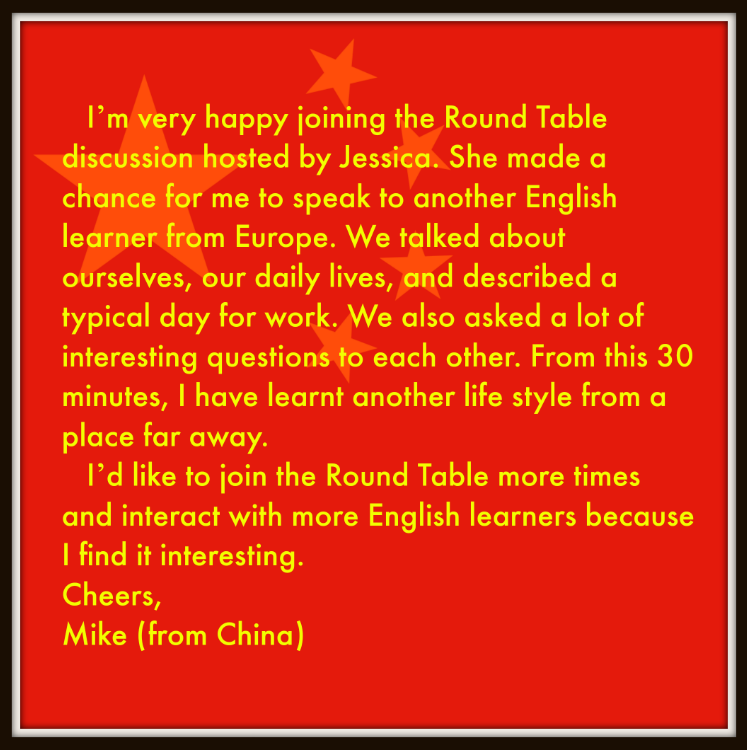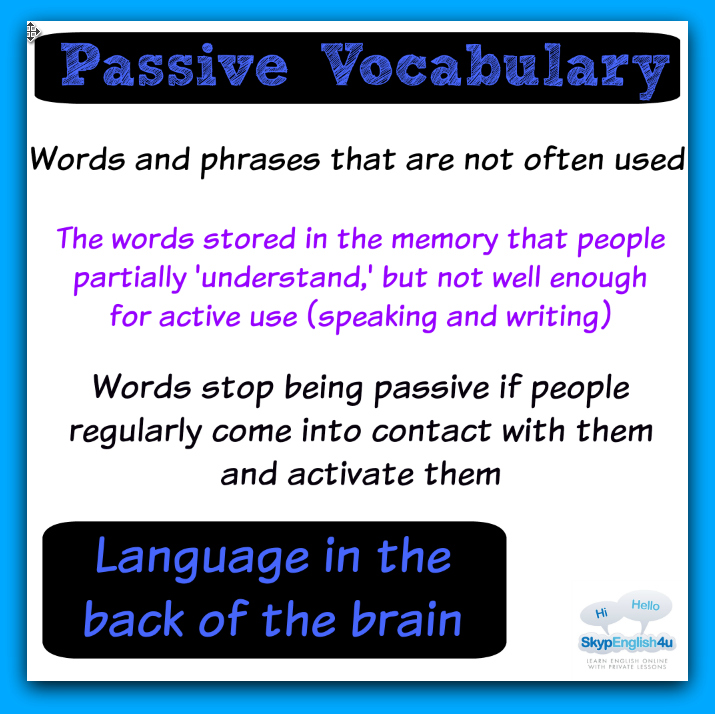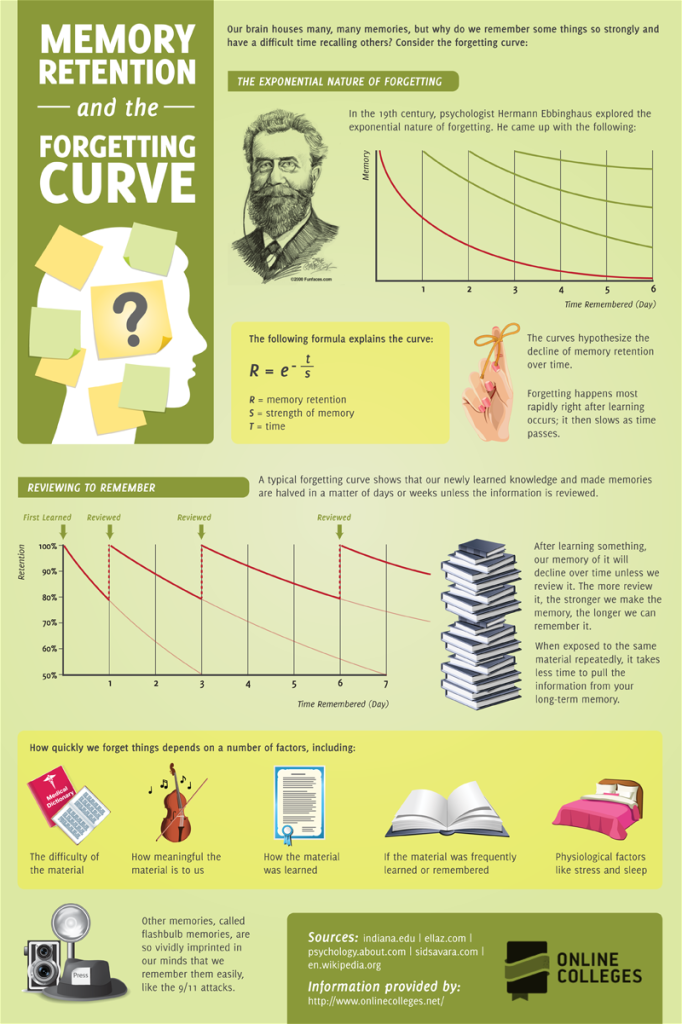Posts
Around the World ‘Round Table’ Discussion
Round Table : a number of people gathered together for conference, discussion of some subject, etc., and often seated at a round table.
Round Table discussions are an excellent way for you to get a chance to practice speaking English with someone from another country and at the same time, learn a bit about their culture and everyday life! You will be exposed to other accents and participate in a ‘real-life’ conversation with someone you have never met before in a comfortable, friendly environment. The general topics are endless and if possible, we can even arrange for you to speak with someone who also works in your industry.
I will serve as the ‘host’ making sure that the conversation keeps flowing and that everyone gets a chance to speak.
Generally we will speak in an order assigned at the beginning of the session. Person 1 gives their answer, 2, then 3 and then it is open for discussion as I see fit. I will help keep the order by speaking directly to the student when they are to answer. During the open discussion, participants must be courteous and not interrupt or speak over other people. At any time, I reserve the right to remove someone from the call.
I will keep running notes of vocabulary, grammar issues and sentence structure in the Skype chat.
Scheduling
This options is only available to SkypEnglish4U clients (join today!) that are ‘pre-approved’ and have the appropriate level of English required to partake in one of these group exercises.
Each SE4U student will get one free 30min AWRT credit and will schedule it with me. If a student wants to participate in more, they will pay a % out of their existing sessions based on the people participating in the call– If there are 2 students, for 30min, they each will spend 15min of their existing packages. The maximum amount of students per call is 3.
You will see specific times labeled as ‘Round Table’ on my google calendar and you can select them just as you regularly schedule. I will be very flexible with these sessions… if you want to do one at a certain time, please let me know and I will try to find another student.
Figurative Language
To truly understand English, you must have some knowledge of the most common types of figurative language.
What does figurative mean?
Figurative means that words are used in a way that is different from the usual meaning. That way the description is more interesting or impressive. Figurative language creates a picture in your mind.
| For example:He is about to explode!
We do not mean to say that the man will actually explode. We only want to say that he is extremely angry. So we use the verb “explode” in a figurativeway. In other words, we use a word that usually describes something else. That way the description is more interesting. It creates a certain picture in the mind. |
 |
The opposite of figurative is literal
Literal means that you mean what you say exactly.
| For example:He is about to explode!
Here we do mean to say that the man will actually explode. The man holds fireworks, and it looks dangerous enough to explode. So here we use the verb “explode” in a literal way. In other words, we use the usual meaning of the word. |
 |
Figurative comes from the word figure (also figure of speech).
- A figure of speech is a word or phrase used in a different way from its usual meaning in order to express a particular meaning.In the about example, “explode” is a figure of speech.
Literal comes from the Latin word littera, which means “letter.”
Jump to:
To get a better understanding of figurative language, let’s look at some common figurative sayings:
This is an example of figurative language.
This sentence does not mean that Sam is actually an animal.

This sentence is a figure of speech meaning that Sam is very messy and does not have good manners.

“Beth let the cat out of the bag
about Lisa’s surprise party.”
This is another example of figurative language.
This sentence does not mean that Beth had a cat in a bag and let it out.

Native English speakers understand this sentence is figurative language meaning that Beth told Lisa the secret about the surprise party.

Figurative or Literal
To truly understand figurative language, you must first understand the terms “figurative” and “literal.”
Literal
If a statement is “literal” it is true. You can believe every word. When you say something “literally,” you mean exactly what you say.

This is a literal statement because the writer thinks the lady looks beautiful. The writer is simply stating that she looks beautiful.

This is a literal statement. The writer means that the man is big and strong.
These statements are literal and can sometimes be boring! To add interest, writers often write in a figurative way.
Figurative
“Figurative” is the opposite of “literal.” You do not believe a figurative statement word for word. When you say something “figuratively,” you are usually making a comparison to give a description or make a point.

This is a figurative statement, because a person can’t really look exactly like money. The statement means that she is well dressed and looks beautiful.


This is also a figurative statement because a person cannot be as big as an elephant. The statement means he is very large. The writer compares the man to an elephant to help the reader visualize the large, strong man!
Continue reading this article on Really Learn English
Difference between SAY, TELL, and SPEAK
If you frequently confuse the words SAY, TELL, and SPEAK, you’re not alone – these are some of the most commonly confused English words! In this lesson, I’ll teach you the rules for the difference between say, tell, and speak.
Tell / Told
Tell means “to give information to a person” – so tell (present) and told (past) are always followed by a person.
Examples:
- Tell me about the movie. Did you like it?
- Peter, I told you not to eat any cookies before dinner!
- Did you tell Sam about what happened at school today?
- The police told us that the situation was under control.
- Derek and Melissa told everybody that they were engaged to be married.
- You should tell her what you think about her idea.
- Don’t worry, I won’t tell anyone your secret.
Say / Said
With say (present) or said (past), we can use these structures:
- say (something)
- say that (something)
- say (something) to (a person)
- “(something)” a person said
Examples:
- Francis says she doesn’t like chocolate.
- I said that the new website design was great.
- What did the teacher say to you when you failed the test?
- “Nice to meet you,” Harry said.
Structures #1 and #2 are the most common in spoken English.
- He said me that he had to leave.
- He told me that he had to leave.
Speak / Spoke
Use speak (present) and spoke (past) with languages, and with talking in general (no specific details). We can use speak with (someone) and speak to (someone)
Examples:
- I speak English.
- Does Donna speak Italian?
- Emma is going to speak in front of 500 people at the conference.
- We spoke to the boss this morning. (general conversation, no specific details)
- I need to speak with you about the new project. (general topic, no details)
In the case of speak with (someone) and speak to (someone), you can also say talk to or talk with.
However, you can’t use “talk” with languages:
- I don’t talk Chinese.
- I don’t speak Chinese.
Find this info and more great articles at Espresso English
Three – It’s The Magic Number
There is something special about the number 3, throughout history it has been a significant number and continues to be so today. The Egyptians built the Pyramids, the Bible talks of the 3 Wise Men and the Holy Trinity. There are 3 primary colours, 3 dimensions, 3 parts to time, we live on the third planet in our Solar System and there are 3 kingdoms on Planet Earth.
I could go on, but we would be here all day, so take a look at this page for more facts about the number 3.
The point I am trying to make is that we use the number 3 in many ways everyday without even realising that we are doing it, and in teaching it can be a very powerful weapon to have in your armour.
Think about it for a second or 3
Stories contain a beginning, middle and ending, and when we speak and use descriptive nouns we tend to use them in threes automatically. Presentations and reports normally include an introduction, main body of information and a conclusion. Our world seems to revolve around the number 3.
So, how can we use the number 3 in language lessons?
I am constantly working with a number of students who are preparing for IELTS speaking test, whose level of English is good, but they just need to show greater fluency on the day. The best little trick I can pass on to them is to think about the number 3.
What I mean is, when you are asked something about yourself, instead of just replying with a single answer such as, ‘I like to watch movies‘, what you need to do is think bigger.
In any answer, you need to think in threes, not in single nouns. So, let’s take movies, drinking coffee and reading as example personal traits, three not one. Next we need to add adjectives to each noun and where possible put them into a specific order of emotion, in order to end up with a response such as: ‘I like to read magazines and drink coffee, but most of all I love to watch movies.’
What you achieve by always thinking in threes is to actually help yourself to achieve greater fluency, which by return means a better score. However, it isn’t just nouns and adjectives that make us seem proficient and fluent. Idioms and phrasal verbs are just as important, and again 3 is the magic number to use. Try to introduce 3 simple idioms and 3 phrasal verbs, and to make sure that you practice using them before your speaking test, so that you understand how and when they are appropriate.
This method actually arms you with 3 tools for getting the score you need on your speaking test; always being able to answer questions with 3 responses, plus 3 idioms and 3 phrasal verbs to use. Interestingly enough, there are 3 parts to an IELTS speaking tests, so the idioms and phrasal verbs can be split equally between them.
For more on the Magic of 3, take a look at this video from EngVid.
[gap height=”15″]
Contact Rachel today > http://www.italki.com/teacher/1394345
[gap height=”15″]
Learning a language… When the time comes to dig in!
I have been trying to learn Russian for a year now, and on a day when my teacher had to cancel the lesson due to a severe cold I sat considering whether I wanted to continue or throw in the towel.
The reason that I started to learn Russian was due to curiosity, since I had a lot of Russian students learning English, but also I wanted to put myself through the student process and see what insight this gave me to help me to improve as a teacher. In this I have achieved many things and it has been an invaluable experience, plus I have been proud of my achievement in understanding the language too, but I also see, with shame, that if I had just tried that bit harder I would have achieved so much more. I have come to truly appreciate that ‘less is more’ when you come across new grammar or concepts. That time to revise and revisit previous learning points is never time wasted. That ‘a little… often’ is priceless advice, and that ultimately homework rules, as it really does reinforce your learning and understanding.
So were there any negatives? Yes. My Italian has suffered and that must now resume priority because I live in Italy. I have seen myself struggle to find words that were once known so well, and have heard myself automatically respond in Russian, then English before finding the correct Italian words. It worries me and I intend to resolve that with haste.
However, I am reluctant to let go of my Russian. I have become extremely interested in the process of learning and the construction of the language itself. I am now curious to see if my return to learning Italian will actually be improved. I have a sneaky suspicion that I will be braver in tackling the more difficult grammar and pronunciation now. I mean, nothing can be as difficult as Russian, surely!
So I conclude, as possibly most students of English do at one time or another, that when you think about giving up, it is really the time when you take stock, appreciate and then prepare to dig in deeper than before. Keep learning! If you’ve taken a break from your English studies over the festive period, now is the time to come back with vengeance and start again. Refresh your memory, renew your efforts, progress to new levels. SkypEnglish4U is the perfect place. We’re a fun group, flexible and friendly. We understand the highs and lows of learning a language. We will help you.
So are you ready? Yeah… Bring it on!
[gap height=”15″]
Contact Rachel today > http://www.italki.com/teacher/1394345
[gap height=”15″]
Memory Retention | Remembering Vocabulary Words
Do you have a good memory? Do you have issues with remembering vocabulary words?
memory ˈmɛm(ə)ri/ noun
1) the faculty by which the mind stores and remembers information “I have a great memory for faces” 2) something remembered from the past “My favorite childhood memory is visiting my Grandmother”
Memory plays a HUGE role in language learning. It is all about remembering vocabulary, grammar rules, idioms, phrasal verbs, the list goes on and on…
In this info graphic from Online Colleges we can see Hermann Ebbinghaus’ ‘forgetting curve’
As you can see, REVIEWING information is very important for retaining the things that you learn. If you do not review, you will quickly forget the things you have just learned.
Reviewing and using the language are a very important part of the learning process. Some people focus on learning new words everyday, but never actually practice using them in a real-life setting. When you actively use a word (with speaking or writing), you are reviewing it. Listening and reading also are forms of reviewing as they are reinforcing the words in your memory, but they are a passive form of review.
Anyone can read a page in the dictionary, but to truly ‘know’ the words, you have to be able to use them.
Get involved! Make it fun! Sign up for speaking sessions, practice daily by commenting on twitter and facebook posts. I’m always happy to respond. Learning new words is very important, but remembering them is even more important.
Greetings
There are different ways to greet people:
Greeting means welcoming someone with particular words or a particular action.
When meeting people formally for the first time, we greet by shaking hands and saying “How do you do?” or “Pleased to meet you.”
“How do you do?” isn’t really a question, it just means “Hello”.
When young people meet informally they sometimes greet and say “Give me five!” and slap their hands together (high five).
Generally we do not greet by shaking hands with people we know well. We greet by just saying ‘hi’ or ‘hello’
Here are some expressions you can use to greet people.
Greeting
Hi, hello.
- Good morning, good afternoon, good evening.
- How are you?
- How are you doing?
- How do you do?
Responding to greeting
- Hi, hello.
- Good morning/Good afternoon/Good evening.
- I’m fine thank you (thanks)/Okey! Thank you (thanks)/Can’t complain/Not bad.
- How about you?/And you?
- How do you do?
Things to remember about greeting:
When you greet someone and say:
“How do you do?“
this isn’t really a question, it just means “Hello”.
10 Fun & Easy Ways to Learn English Faster
There are tons of podcasts about all topics imaginable these days: entertainment, politics, news. A good way to find one is to look for a podcast from a TV channel you usually watch in your cable TV. Look for one that interests you and listen to it in your car while driving. You’ll train your ear that way!
Most of them are hilarious! It will be so worth it. Try looking at the comments to pick up some words and sentences you aren’t familiar with, but be careful there is all kinds of bizarre stuff in YouTube comments.
When you are alone at home, or of course in the shower, start talking! Sing a song in English the way it sounds to you, talk about the weather or any other topic. Do this frequently and your pronunciation will drastically improve – guaranteed!
You can spend hours doing that listening to interviews and it sure won’t feel like studying. But it is! It helps you a great deal.
Okay now don’t be a creepy eavesdropper! But, see what words you can pick up and listen to the flow of the conversation. How much did you understand? What general topic were they talking about? Did you hear an interesting word you might want to look up after?
Look and think about what these ads mean. How many words do you recognize? Did you see that same word elsewhere? Make up sentences about what you’re seeing.
Watch video clips with lyrics on YouTube and sing along. Read the translation and build up your vocabulary. Listen to “clean” versions of songs and try to figure out what dirty words were taken out. It’s fun!
It doesn’t matter if you don’t understand what they’re saying, watch anyway! Try to understand why something is funny or sad . If the joke is related to the word itself, then maybe that is why the joke does not make sense in your native language. What would be the best translation into your language then?
When you have English speakers in your timeline, you see their posts daily and get inside information about news and viral videos in English. Your friends can be your teachers! Their timeline basically sort out the best material for you to study.
Help out a tourist who looks lost. They won’t mind you struggling with the language while you’re doing them a favor! After class, talk to your teacher about how things are going and what you need help with in English. When traveling, ask around for directions in English, even if you don’t need them! Try purchasing things online and by phone, or using customer support in English.
It does not matter if you talk slowly, you are learning, that’s only natural!
The translation sometimes does not correspond directly to the original. Find out what the original title really means. Ask yourself how the translation makes sense. What is the relation to the movie? You will never forget a new word that once it’s associated with an unforgettable movie. Works every time!




